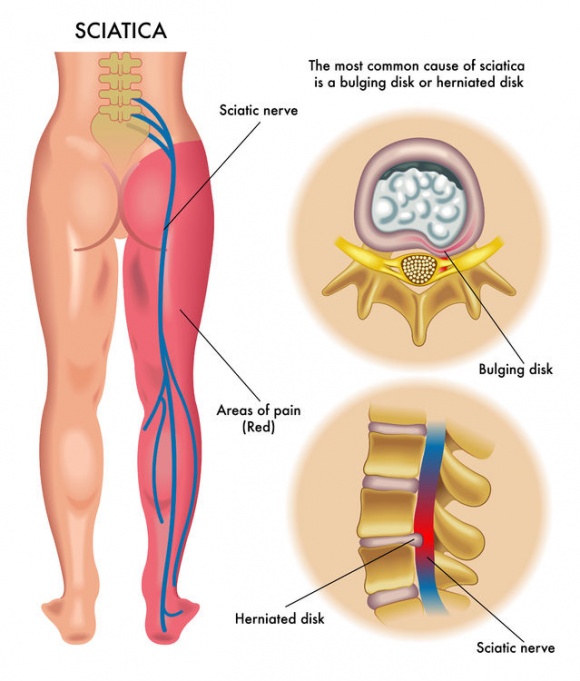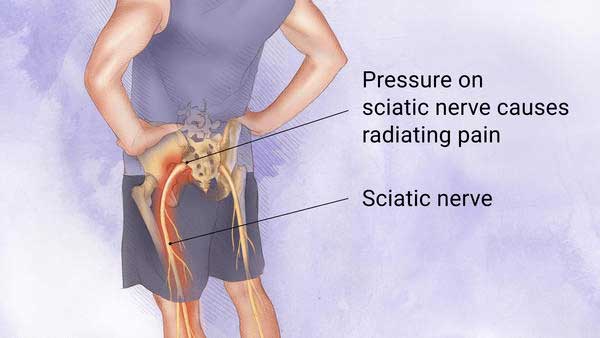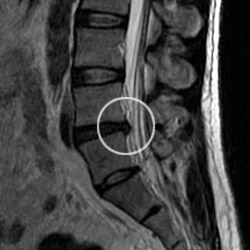When to consider chiropractic for sciatica?
Sciatica is one of those conditions that people often mention, but few fully understand until it affects them. It’s more than just a sore back or stiff leg. It can cause sharp, shooting pain that travels down the leg, sometimes making it difficult to sit, stand, or even sleep comfortably.
For some, the pain comes and goes; for others, it can linger for weeks or even months, affecting their ability to work, drive, or enjoy simple daily activities. The impact can be both physical and emotional, especially when relief feels out of reach.
What is sciatica?
Sciatica refers to pain caused by irritation or compression of the sciatic nerve, the longest nerve in the body, which runs from your lower back down through your hips and legs.

Figure 1: Diagram of the sciatic nerve, including close-ups of bulging and herniated discs that can compress the nerve and cause pain.
Common causes include:
- A herniated (or “slipped”) disc
- Spinal stenosis (narrowing of the spinal canal)
- Piriformis syndrome (where a muscle irritates the nerve)
- Injuries or ongoing postural strain
Symptoms of sciatica
The symptoms of sciatica can vary, but they often include pain that radiates from the lower back down the leg, numbness or tingling sensations, and muscle weakness. Some people also experience a burning or electric shock-like feeling. For many individuals, sciatica can make simple tasks, such as walking, bending, or even sitting, uncomfortable or painful.
Traditional treatments for sciatica
Conventional approaches typically focus on managing the symptoms of sciatica rather than addressing the underlying cause. These treatments often involve over-the-counter or prescription pain relief, anti-inflammatory medications, physiotherapy, or stretching exercises. In some cases, cortisone (steroid) injections may be used, and in severe instances, surgery, such as a microdiscectomy, might be considered.
While these treatments can provide short-term relief, they are not always effective in the long term. Medications, in particular, can come with side effects or may lose their effectiveness over time.
How chiropractic care works
Chiropractic care is based on the idea that proper alignment of the spine supports the nervous system and helps the body function at its best.
Chiropractors use techniques such as:
- Spinal adjustments to restore movement
- Mobilisation and soft tissue therapy
- Exercises and advice to support healing
The goal isn’t just pain relief, it’s about improving how your body moves and helping it work more efficiently without relying on medication.
Can chiropractic help with sciatica?
In many cases, chiropractic care can be beneficial, particularly if sciatica is caused by spinal misalignments or pressure on the nerve roots. Chiropractic adjustments work by relieving that pressure, which can help improve your symptoms. Chiropractors focus on reducing inflammation around the sciatic nerve, improving spinal motion, and supporting better posture and movement patterns.

Figure 2: Illustration highlighting the sciatic nerve and how compression near the lower spine can lead to radiating leg pain.
Research into chiropractic care for sciatica has shown encouraging results. Many patients report experiencing reduced pain, increased mobility, and fewer flare-ups over time. Since every case is unique, a typical chiropractic plan usually involves several sessions over the course of a few weeks, with progress being monitored as treatment progresses.
Benefits of chiropractic care for sciatica
Chiropractic care offers several potential benefits for those suffering from sciatica. It can provide relief from nerve pain without the need for painkillers, allowing patients to manage their discomfort naturally. Additionally, chiropractic treatment can improve movement and flexibility, helping individuals regain mobility.
Rather than waiting for symptoms to fade, chiropractic care encourages a more active recovery, promoting healing through targeted interventions. Ongoing support is also available to help prevent future issues, ensuring that the benefits last long-term. Moreover, chiropractic care is personalised, focusing on your unique needs and goals to deliver the most effective results.
What to expect during a chiropractic visit
During your first visit, you can expect a detailed discussion about your symptoms and medical history. Your chiropractor will then conduct a physical exam to assess your movement, posture, and nerve function. If necessary, imaging such as X-rays or an MRI may be recommended to gain further insight.

Figure 3: MRI scan indicating a potential disc herniation in the lower spine—one of the most common structural causes of sciatica.
Based on this information, your chiropractor will outline a personalised care plan, which could include spinal adjustments, advice on posture, stretches, and follow-up appointments. The care provided is always tailored to your specific needs and should be gentle, considered, and safe.
When to consider chiropractic care for sciatica
If your sciatica hasn’t improved with rest or over-the-counter treatments or if you’re looking for a more natural, hands-on solution chiropractic care may be worth considering. It’s especially helpful if you’re experiencing ongoing flare-ups and want to get to the root cause rather than just treating the symptoms.

However, it’s not always the right fit. If you’re experiencing sudden leg weakness, loss of bladder or bowel control, or suspect an underlying condition like a tumour or infection, it’s crucial to seek immediate medical attention. A good chiropractor will always know when to refer you to a specialist for further investigation.
To help explain how chiropractic care can help with sciatica, Dr. David Black shares a recent case and talks through his approach. Now in his 89th year and celebrating four decades in practice, Dr. David continues to treat patients with the same passion he’s had since the beginning.
Chiropractors That Treat Sciatica
If you’re struggling with sciatica, Drs. Michael and David Black have over 40 years of experience helping people just like you. They’re experts in providing safe, effective relief using both traditional and modern chiropractic techniques. As BUPA Members First Providers, we offer savings for BUPA clients and handle your private health fund claims electronically. We also accept Medicare EPC referrals. If you need emergency care, we’re available after hours by appointment.
To book your appointment at either our Armadale or Doncaster clinics, give us a call on (03) 9509 7691 today.

